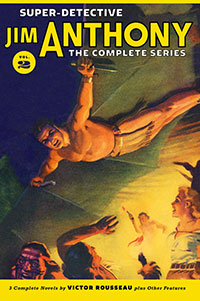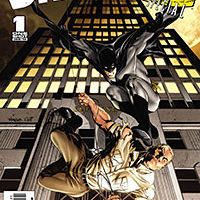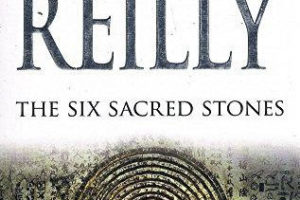 For those not familiar, Jim Anthony was a sort-of Doc Savage clone published by Trojan/Culture Publications in the early 1940s, a publisher of the “spicy” pulps, a sort-of soft porn magazine.
For those not familiar, Jim Anthony was a sort-of Doc Savage clone published by Trojan/Culture Publications in the early 1940s, a publisher of the “spicy” pulps, a sort-of soft porn magazine.
He lasted 25 stories, and Altus Press is reprinting the whole series. My previous posting was on the first volume, and now I look at “Super-Detective Jim Anthony: The Complete Series, Vol. 2,” with the fourth, fifth, and sixth novel.
Jim Anthony was “half Irish, half Indian, and all-American.” More emotional than Doc, Anthony was a physical and mental marvel. He had a penthouse in the Waldorf-Anthony Hotel he owned and had a secret mansion in the Catskills called “The Tepee.” He was assisted by a small group of people including Tom Gentry, pilot and right-hand man; Mephito, his shaman grandfather; Dawkins, his butler; and Dolores Colquitte, the daughter of a U.S. senator and his fiance (something unusual, as while some pulp heroes had a love interest, none were noted as their fiance). He also owned the Star, a newspaper in New York and made use of it in his adventures.
His series ran for 25 issues of Super-Detective magazine in 1940-43. For the first 10 or so issues, he was “Super Jim Anthony” (as most refer to him today), where he fought against science-fictional menaces. After that, he was sort of “de-powered” and lost most of his aides except for Tom. He turned into more of a hard-boiled detective. He would soon be written by the authors of Trojan’s Dan Turner, Hollywood Detective: R.L. Bellem and W.T. Ballard for the last 10 issues. At the beginning he was written by Victor Rousseau Emmanuel. It is now believed that he wrote the first 12 stories, while stories 13, 14, and 15 were by Edwin Truett Long, who also wrote the Doc Harker series.
As noted, this volume reprints the second trio of stories, all by Rousseau. It also has an intro that focuses on Rousseau, by someone who also wrote a bio-bibliography on him. Also included with this volume are the letter pages from each of the stories, which I’ve not seen before. It’s kind of interesting to read these letters from the original fans. The original covers of the pulps are shown on the back cover, the first of these is used as the cover, and interior art is also included. It’s interesting that the interior artwork always seems to show Anthony running around in his swim trunks, and the girls in the story in various skimpy or form-fitting outfits, as befitting a “spicy” publisher.
The stories in this collection are “Bloated Death,” “Killer in Yellow,” and “Murder in Paradise.” I was surprised that “Bloated Death” made references to the prior novels and further that “Murder in Paradise” is a direct sequel to “Killer in Yellow,” because it’s very rare to have such continuing stories in the hero pulps. So will we see more during the rest of Rousseau’s term on the character?
In “Bloated Death” we learn more about Anthony. We learn his parents were lost at sea when he was 7, and he was raised by his grandfather, and he became involved in criminology a couple of years after college (most likely in his early/mid 20s). We are told about Rado Ruric, who had plagued Anthony in the first three novels, only to be killed off in the third, and that Anthony had been opposing him for four years. References to past stories are rare in the hero pulps, almost unheard of. In a funk after his past cases, he decides to take a vacation to Manitoba, and is involved in a strange case of the “bloated death.” Will he unmask the cause of this before more people fall victim to it? Including Dolores?
The next story, “Killer in Yellow,” takes a little bit of time to get us to the mystery. I found it a little funny that Anthony’s boat is called the Isaac Walton, but the artist called it the Dolores. Anthony and friends are on a fishing trip in the Gulf of Mexico, when they encounter a rich playboy on his yacht being picketed by protesters. He is killed when his boat sinks, caused when the water changes characteristics and no longer acts normally. A “Mr. X” is blamed, and several people are after him. We soon learn that Mr. X is really Tom Gentry’s father, a professor on atomics missing for almost 15 years. And the leading protester is the estranged son of Ormilin, a millionaire atomic scientist who has been missing for almost 15 years with his followers, who set out to build his own paradise! Gentry’s father suffers from amnesia, so can’t say where he was. Anthony is able to solve the mystery of the murdered playboy and catch the guilty parties, but now the hunt is on for Ormilin.
“Murder in Paradise” continues the story, as the location of Ormilin’s atomic utopia, the city of Paradise, must be found. We also learn that the story is set in 1940 (so we have a specific time for when Anthony has been operating), and we learned in the last story that he has been operating against criminals for six years. In looking for Ormilin, a surgeon works on Professor Gentry to restore his memory. It works, and now we know the city of Paradise is located in a fjord on the west coast of Greenland. And it’s clear that other nations, not surprising, are also looking for the city to gain Ormilin’s atomic secrets. Will Anthony succeed in finding Ormilin’s Paradise? Will he be able to escape? Will he be able to prevent enemy nations from using Ormilin’s atomic secrets?
Overall, another good collection of this character, which shows he’s more original than just another Doc clone. I look forward to the next volume, especially to see how the stories work out. Will we see more continuation of storylines and the like? Can’t wait.



